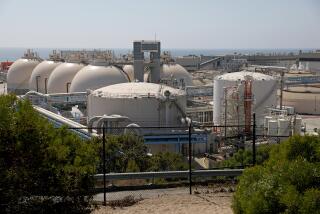Water pollution traced to La Brea Tar Pits
For years, residents living near Ballona Creek and environmentalists have complained of mysterious sheens of oil and grease in the western Los Angeles County waterway, often blaming industrial dumping, urban runoff or other man-made causes for the pollution.
One cause that apparently never crossed their minds: the La Brea Tar Pits.
It turns out the tourist attraction and preferred field trip destination of seemingly every grade schooler in the region has sent oily wastewater spilling into the highly polluted creek.
The tar pits, in Wilshire Boulevard’s Miracle Mile neighborhood, overflow during heavy rains, overwhelming the devices that separate oil from water. Polluted runoff then gets into the storm drain system, spilling into the creek and emptying into the ocean, according to county planners.
It’s unclear how big a polluter the naturally occurring tar pits have been. Still, the release of pollutants has cost the county money.
The Page Museum and Natural History Museum of Los Angeles County have paid regional water regulators $15,000 in fines for releasing polluted water into the storm drains in 2006. And in 2002, the Page Museum paid $3,000 to a coastal cleanup project to settle a stormwater discharge violation.
Since 2009, the county has pumped excess water from the area into the sewer system, where it is treated before being released into the ocean. The measure was designed to be only temporary, and Los Angeles County supervisors voted earlier this month to spend $2 million to build a new system that will clean the water before it is deposited into the sewers.
Most environmentalists admit they weren’t aware that the tar pits had contributed to toxic runoff, though when pressed, they say it makes sense.
“It does seem obvious when you think about it. That kind of pollution has been occurring long before [humans] ever got here,” said Jim Lamm, president of the Ballona Creek Renaissance, a Culver City-based volunteer group.
The pits are the result of oil seeping up through the ground; since the last ice age they have trapped thousands of animals, including woolly mammoths and saber tooth tigers. The pits attract about 350,000 visitors annually.
Other groups have said previous oil slicks have caused serious damage to birds and plants, and they questioned whether the temporary solution could successfully catch all of the tar pit runoff.
“Those pollutants can have a pretty severe effect on species,” said Liz Crosson, executive director of Santa Monica Baykeeper, which has sued the county over the polluted runoff released into the region’s larger urban waterways, including the Los Angeles and San Gabriel rivers.
With the tar pit pollution, Crosson said, “it’s disappointing that it’s taken five years or more for L.A. County to take action. But I’m glad to see they’re putting in a more permanent solution.”
More to Read
Sign up for Essential California
The most important California stories and recommendations in your inbox every morning.
You may occasionally receive promotional content from the Los Angeles Times.












